
One of the features on StockCharts.com is the ability to chart the seasonality of any stock, index or even indicator as long as it has a defined symbol. We often talk about the Santa Claus Rally that arrives in December and sometimes moves into January. I decided to do a seasonality chart of both the SPY and Nasdaq ($COMPQ). I was somewhat surprised by the results.
April and November are the best months for the SPY over the past 20 years. 80% of the time it is up 2.5% and 2.1% respectively. December is still a positive month for the SPY, but not the best month. January is mixed/neutral as 45% of the time it is down an average -0.1%. Definitely not a great month and something we should consider as we move into the new year.
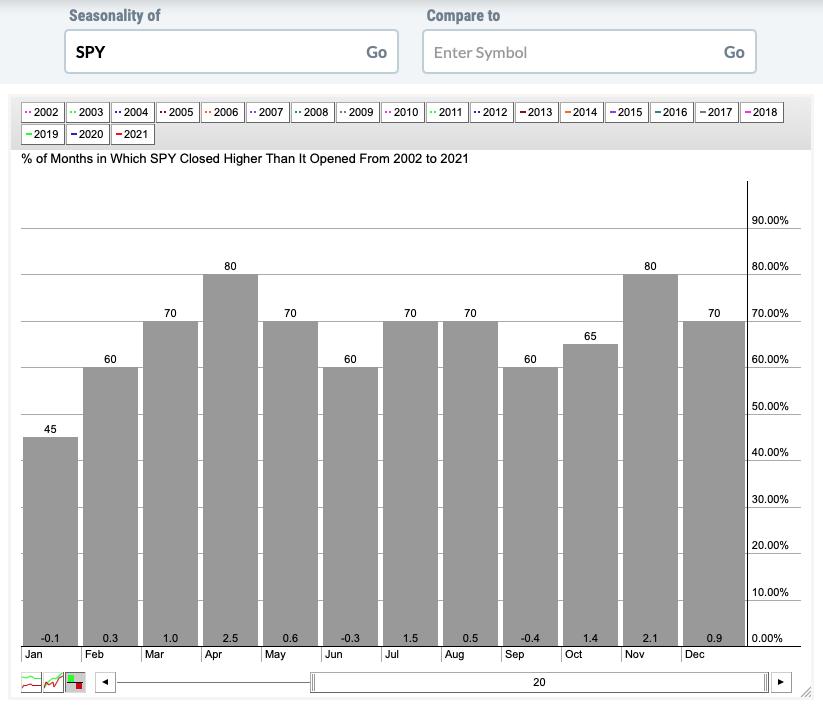
November is the clear winner for the Nasdaq as 80% of the time it is up an average of 2.1%. December and January see a drop. April and October are strong, but not as strong as November.
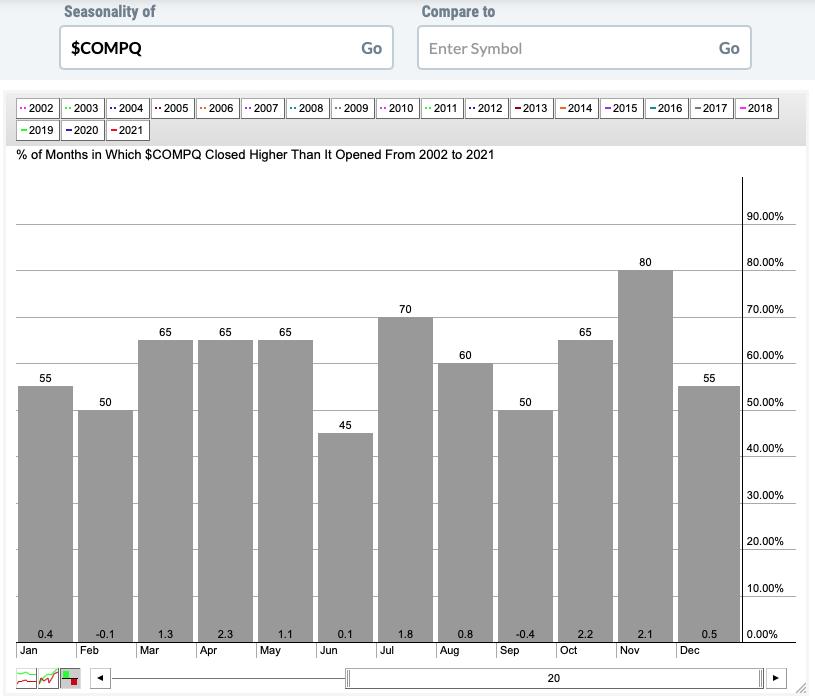
The "Santa Claus" rally is mostly confined to the holiday trading between 12/24 and 1/3 (depending on how the dates fall). Unfortunately I don't have the ability to chart those dates specifically, but I would wager we would see strong seasonality on them. Seasonality is interesting, but not anything you can use to trade with. It does suggest certain seasonal biases and that can be helpful.
The DecisionPoint Alert Weekly Wrap presents an end-of-week assessment of the trend and condition of the Stock Market, the U.S. Dollar, Gold, Crude Oil, and Bonds. The DecisionPoint Alert daily report (Monday through Thursday) is abbreviated and gives updates on the Weekly Wrap assessments.
Watch the latest episode of DecisionPoint on StockCharts TV's YouTube channel here!
MAJOR MARKET INDEXES
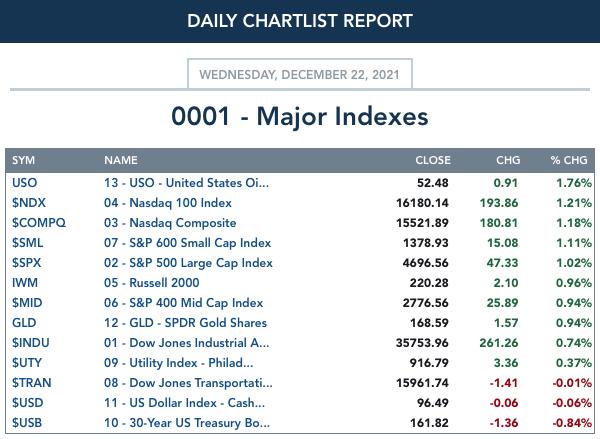
SECTORS
Each S&P 500 Index component stock is assigned to one, and only one, of 11 major sectors. This is a snapshot of the Intermediate-Term (Silver Cross) and Long-Term (Golden Cross) Trend Model signal status for those sectors.
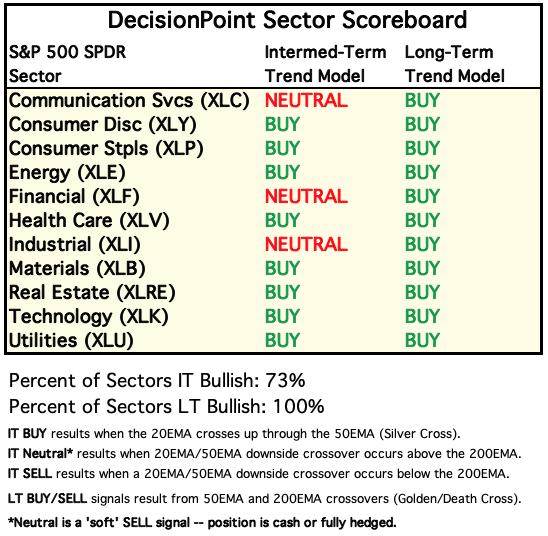
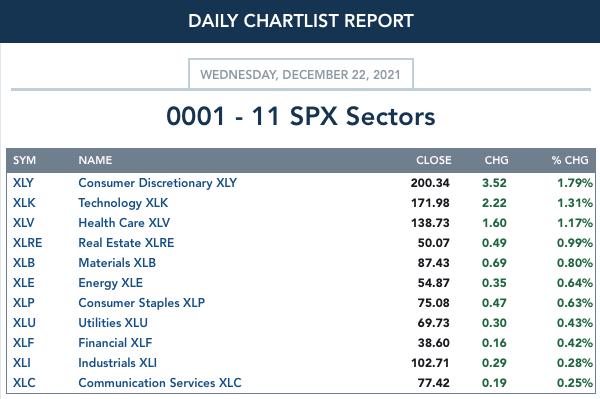
RRG® Chart: Yesterday's comments still apply:
"All of the sectors that are in the Leading quadrant are 'defensive' in nature. XLC is showing marked improvement and could offer some interesting beatdown opportunities. All other sectors are bearishly configured."
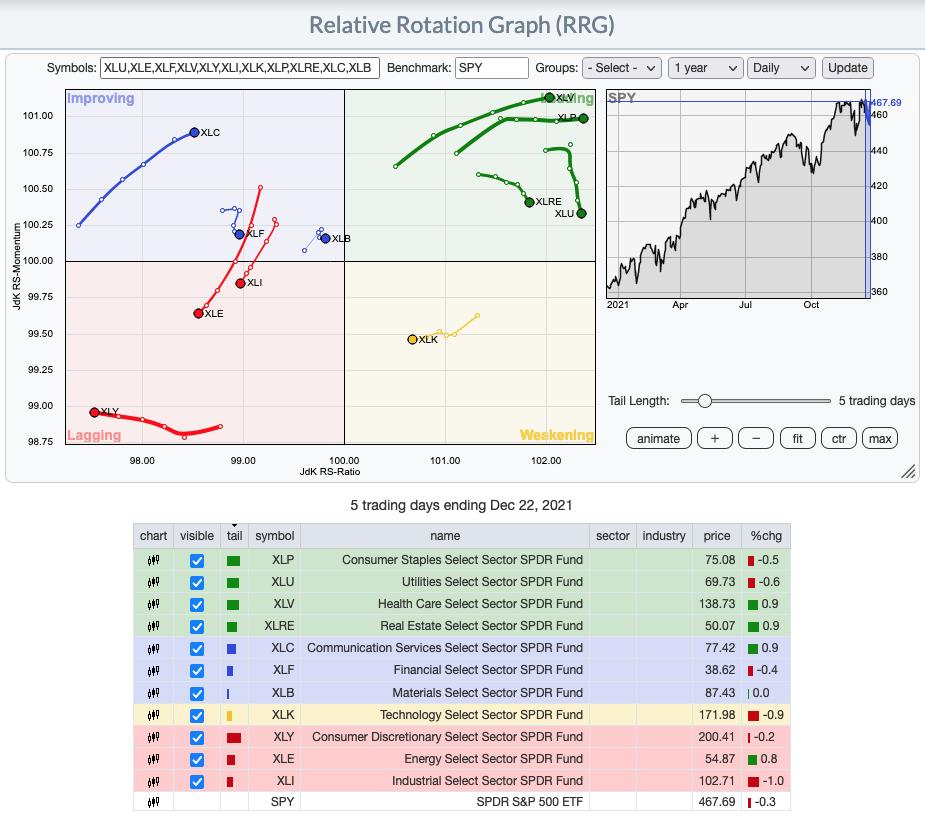
RRG® charts show you the relative strength and momentum for a group of stocks. Stocks with strong relative strength and momentum appear in the green Leading quadrant. As relative momentum fades, they typically move into the yellow Weakening quadrant. If relative strength then fades, they move into the red Lagging quadrant. Finally, when momentum starts to pick up again, they shift into the blue Improving quadrant.
CLICK HERE for an animated version of the RRG chart.
CLICK HERE for Carl's annotated Sector charts.
THE MARKET (S&P 500)
IT Trend Model: BUY as of 10/18/2021
LT Trend Model: BUY as of 6/8/2020
SPY Daily Chart: Total Volume was thin today. Price continued to rise strongly, but overhead resistance is arriving soon. The PMO is rising again; however it is still on a crossover SELL signal. The VIX is moving quickly to the upper Bollinger Band which is bullish.
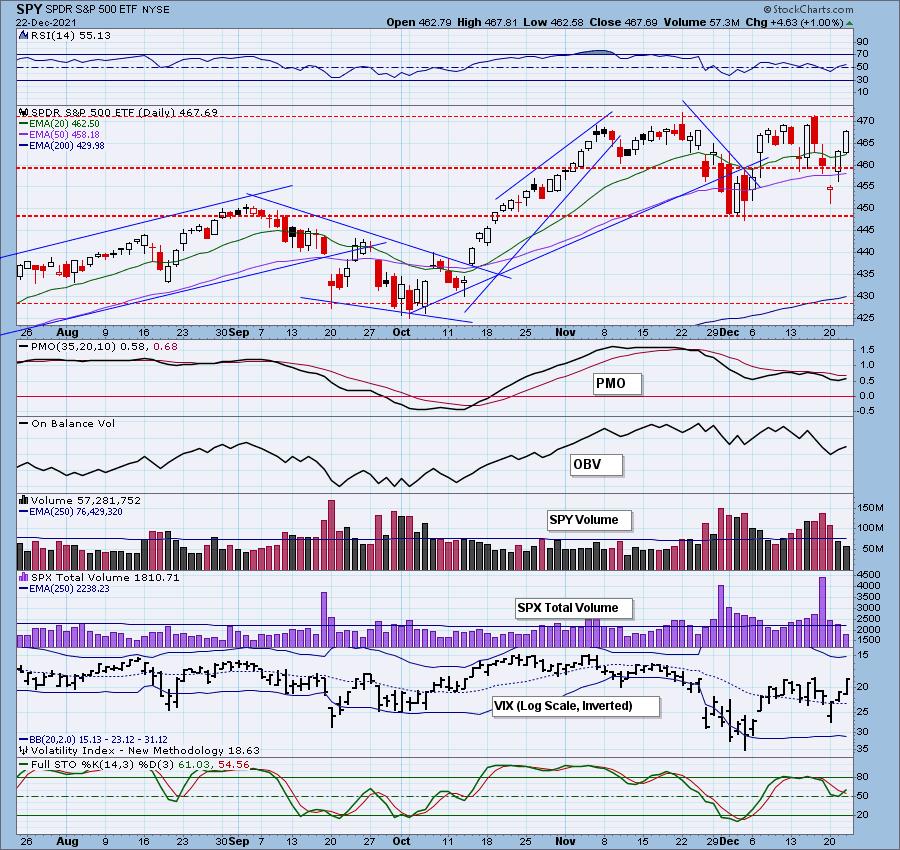
Stochastics reversed in positive territory and display a positive crossover.
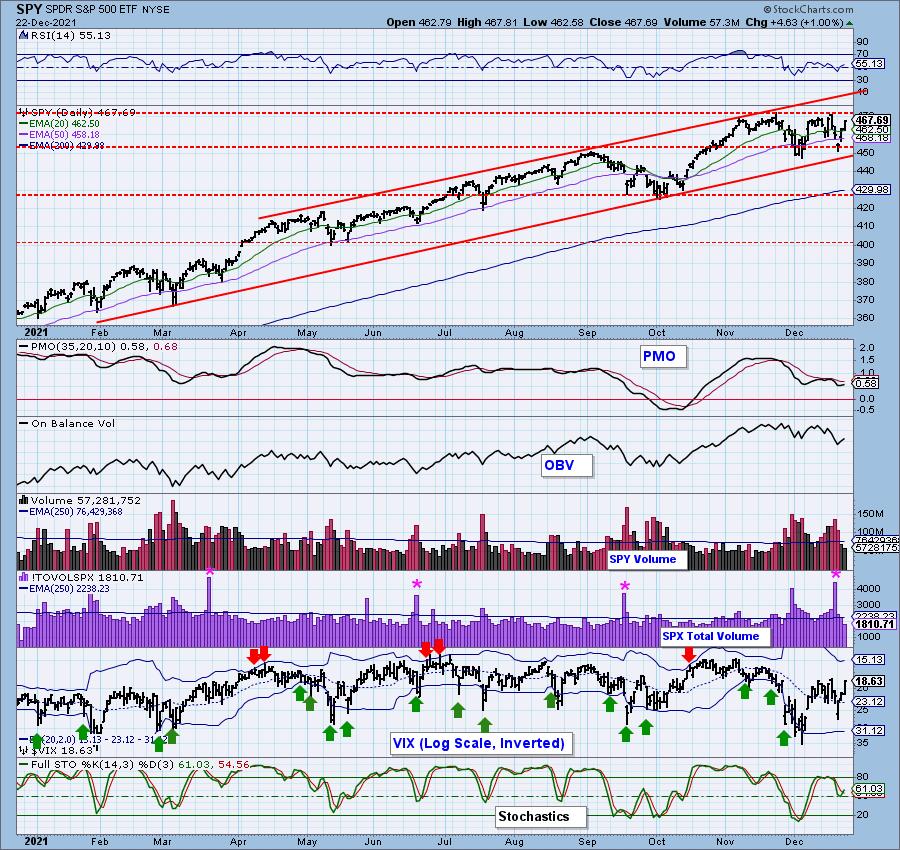
PARTICIPATION: The following chart objectively shows the depth and trend of participation in two time frames.
- Intermediate-Term - the Silver Cross Index (SCI) shows the percentage of SPX stocks on IT Trend Model BUY signals (20-EMA > 50-EMA). The opposite of the Silver Cross is a "Dark Cross" -- those stocks are, at the very least, in a correction.
- Long-Term - the Golden Cross Index (GCI) shows the percentage of SPX stocks on LT Trend Model BUY signals (50-EMA > 200-EMA). The opposite of a Golden Cross is the "Death Cross" -- those stocks are in a bear market.
Despite the continuation of the yesterday's rally the SCI turned down again after ticking up yesterday. The GCI which had been rising turned over today before initiating a positive cross over the signal line. The SCI reading is bearish and not oversold. The GCI reading is bullish above 70%. I'll talk bias further down.
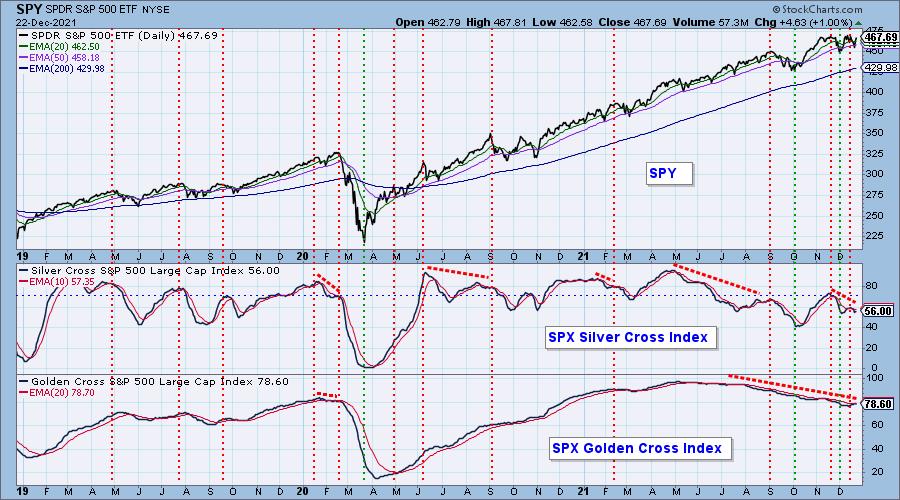
S&P 500 New 52-Week Highs/Lows: New Highs expanded again which makes sense. There were no New Lows, but we haven't seen too many since late November. The 10-DMA of the High-Low Differential continues lower, but is decelerating somewhat. The configuration is still negative.
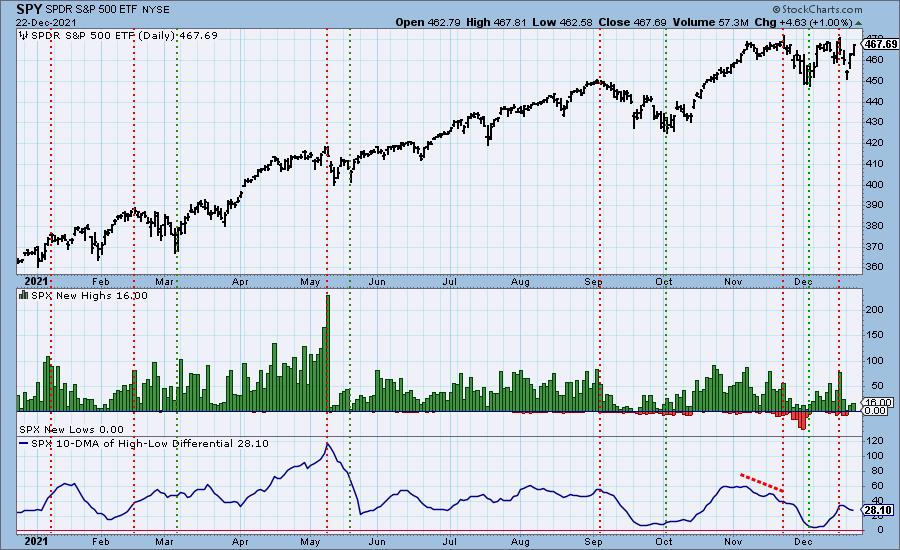
Climax* Analysis: We'd like to call attention to yesterday's NYSE UP/DOWN Volume Ratio reading. Unfortunately, it was late updating and was not available when we published; nevertheless, it is still worth noting, if only in retrospect. It reached a reading of 6.0, which shows a lot of conviction behind the move. We are still faced with the high frequency of climax events in the last three weeks, and the fact that SPY is in a trading range, the top of which is nearly two months long. High volatility and an inability to break out of the range.
Today we have climaxes in SPX Net A-D, Net A-D Volume, and the UP/DOWN Volume Ratios, so we have to call an upside exhaustion climax, which could be a warning that the top of the trading range will once again be a problem. Maybe that's not such a bad interpretation because SPX Total Volume was quite thin due to holiday trading.
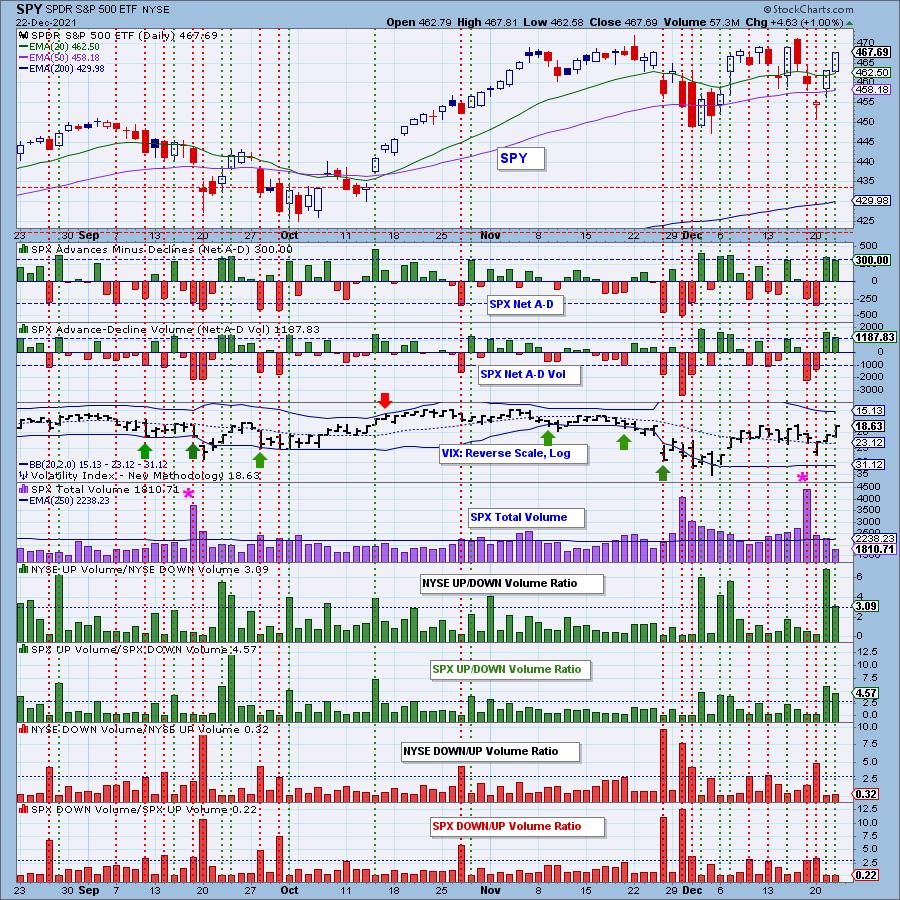
*A climax is a one-day event when market action generates very high readings in, primarily, breadth and volume indicators. We also include the VIX, watching for it to penetrate outside the Bollinger Band envelope. The vertical dotted lines mark climax days -- red for downside climaxes, and green for upside. Climaxes indicate either initiation or exhaustion.
Short-Term Market Indicators: The short-term market trend is DOWN and the condition is NEUTRAL.
The STOs continued to rise but are in neutral territory. We did see participation break declining trends which is positive.
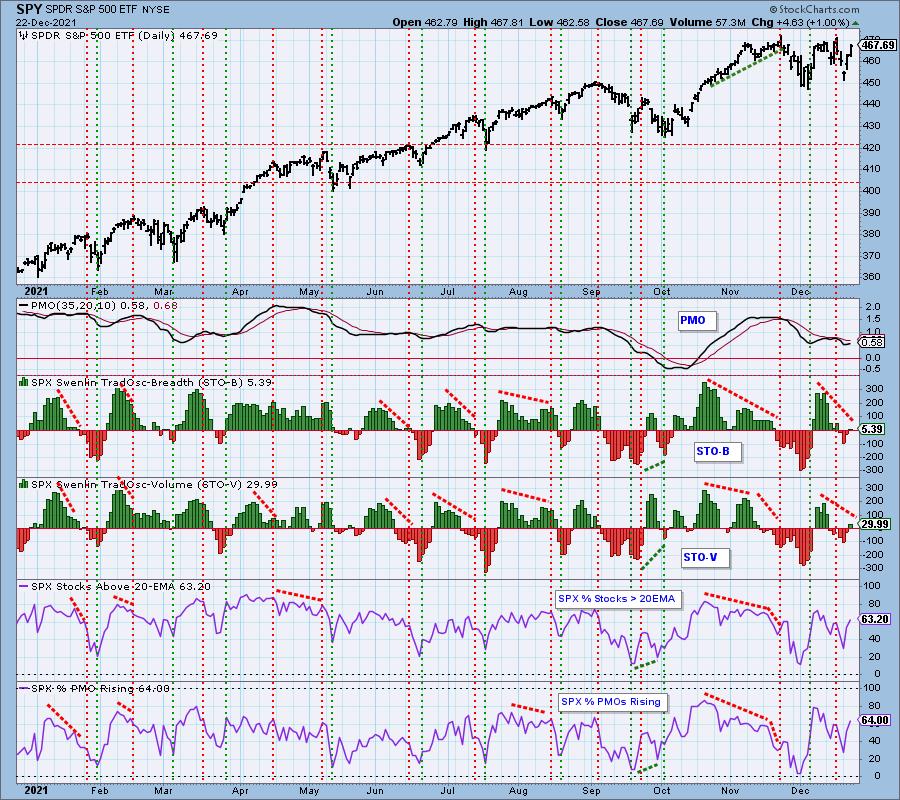
Intermediate-Term Market Indicators: The intermediate-term market trend is UP and the condition is NEUTRAL.
The ITBM and ITVM rose again and are mostly neutral given the proximity to the zero lines. I like seeing more PMO crossover BUY signals, but a reading below 50% is far from bullish.
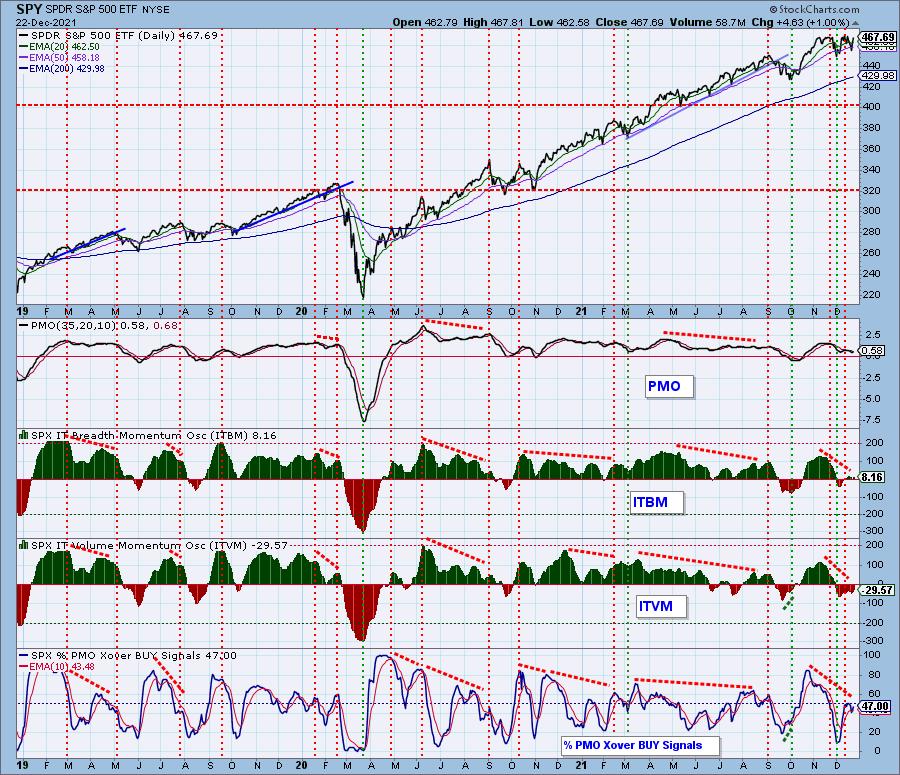
Bias Assessment: The bearish bias continues to diminish, but it isn't particularly bullish yet. Participation of stocks > 20/50-EMAs is slightly higher than the 56% SCI reading which moves the bias in the short term and intermediate term to somewhat bullish or even neutral. The long-term bias is deteriorating. The GCI turned down and %Stocks > 200-EMAs is lower than the GCI reading. It isn't a bearish bias. We would still read it as bullish given both %Stocks > 200-EMAs and GCI are above 70%.
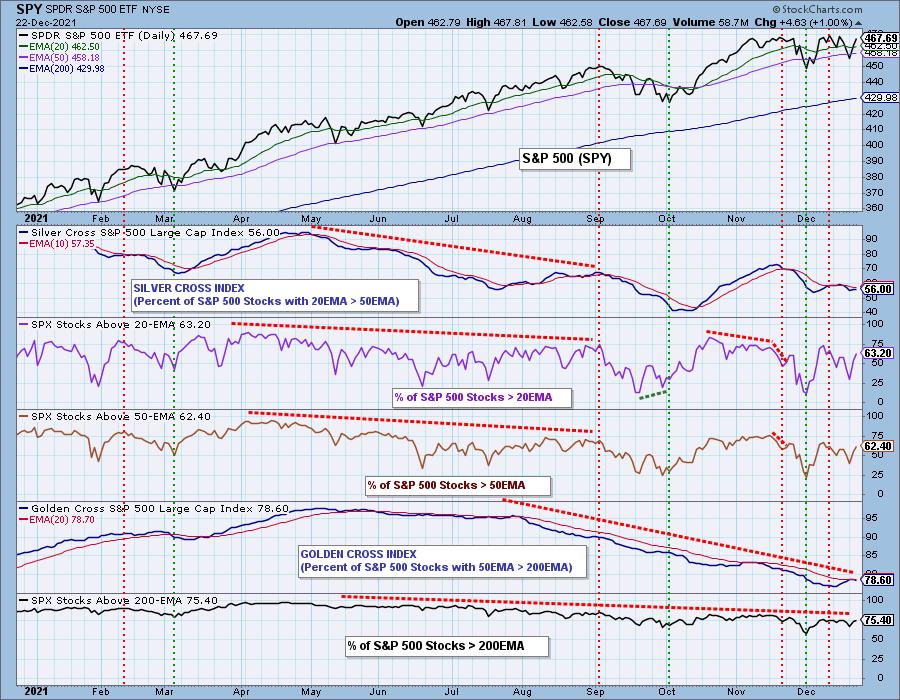
CONCLUSION: The day after Thanksgiving, the ultimate in holiday trading, saw a surge in volume and a strong decline. While today's total volume can be attributed to holiday trading, it could also suggest the rally is ready to end as buyers could be drying up. The holiday muddies the water here, but certainly Volume Ratios and Breadth tell us today was an upside exhaustion climax. Given price is near all-time highs an exhaustion makes sense. We still believe that the rest of the year will see more volatile trading in the existing trading channel between $445 and $470 for the SPY.
I'm 10% exposed to the market with no plans to expand my portfolio.
Have you subscribed the DecisionPoint Diamonds yet? DP does the work for you by providing handpicked stocks/ETFs from exclusive DP scans! Add it with a discount! Contact support@decisionpoint.com for more information!
BITCOIN
Yesterday's comments still apply:
"Bitcoin finally broke from the short-term declining trend. I've annotated a bullish falling wedge. The PMO managed a crossover BUY signal and Stochastics are looking up on this small upside breakout from the wedge. Price is still not above the 200-EMA so the bias is still bearish on Bitcoin."
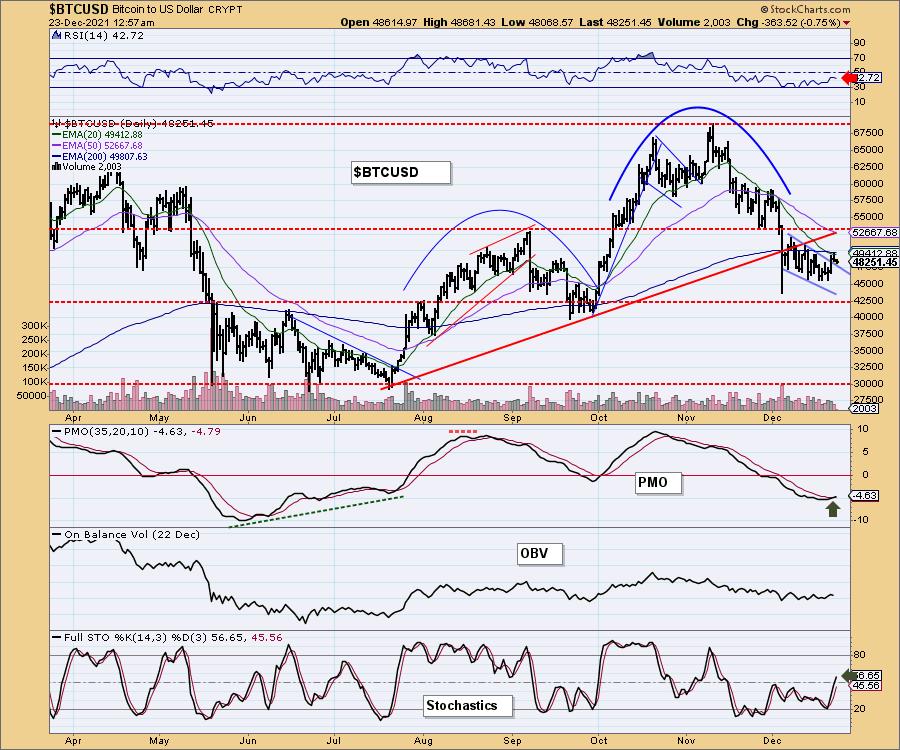
INTEREST RATES
Rates are directionless and moving mostly sideways.
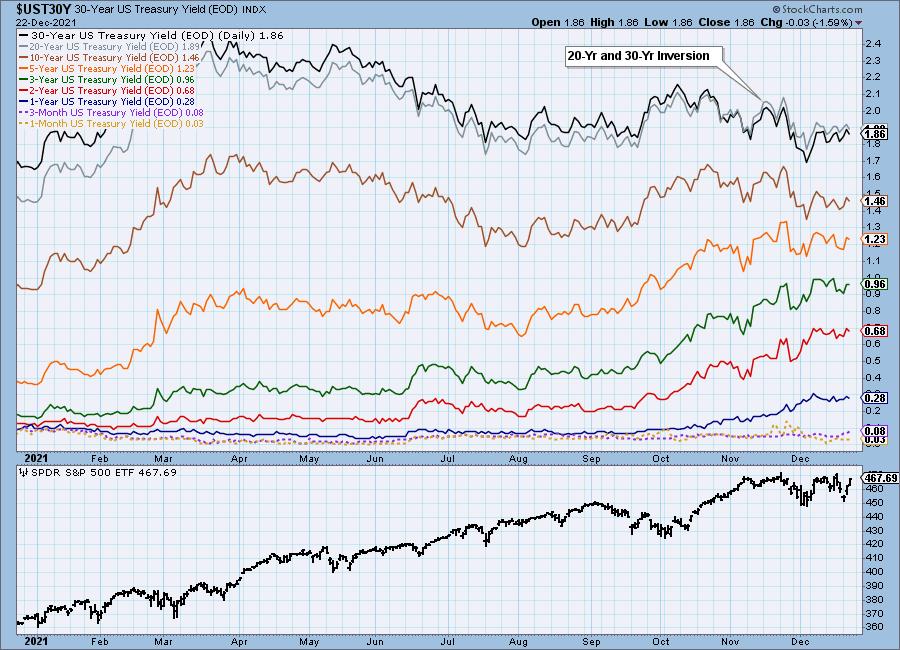
10-YEAR T-BOND YIELD
The 10-year yield lost two basis points today, keeping the rounded top in play. If we see a breakout above the double-bottom confirmation line at 15.5, the minimum upside target would be around 17.0. That would mean a breakout from this topping formation. Stochastics are rising and are now above net neutral (50). The RSI on the other hand turned down. The PMO is turning up. With the 50-EMA holding as resistance, it may be some time before we see this rounded price top break.
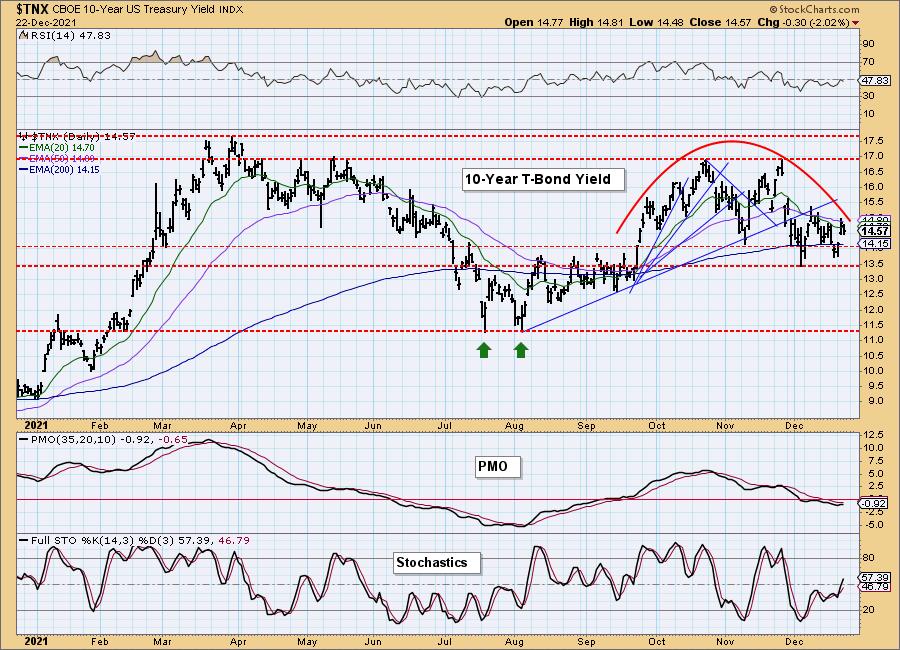
DOLLAR (UUP)
IT Trend Model: BUY as of 6/22/2021
LT Trend Model: BUY as of 8/19/2021
UUP Daily Chart: The Dollar is moving sideways inside a symmetrical triangle, but today closed below the 20-EMA. Typically these patterns are continuations, so we should expect and upside breakout. There are problems though.
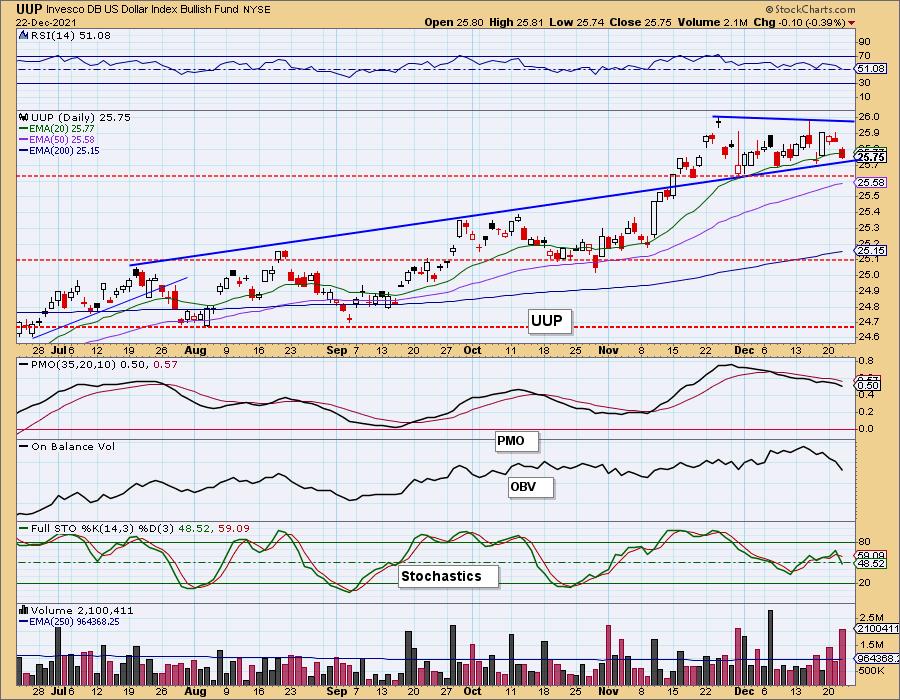
While the RSI is still in positive territory, it is falling. The PMO is still on a SELL signal and has yet to turn back up. Stochastics are a big problem having turned back down and entered negative territory below net neutral (50).
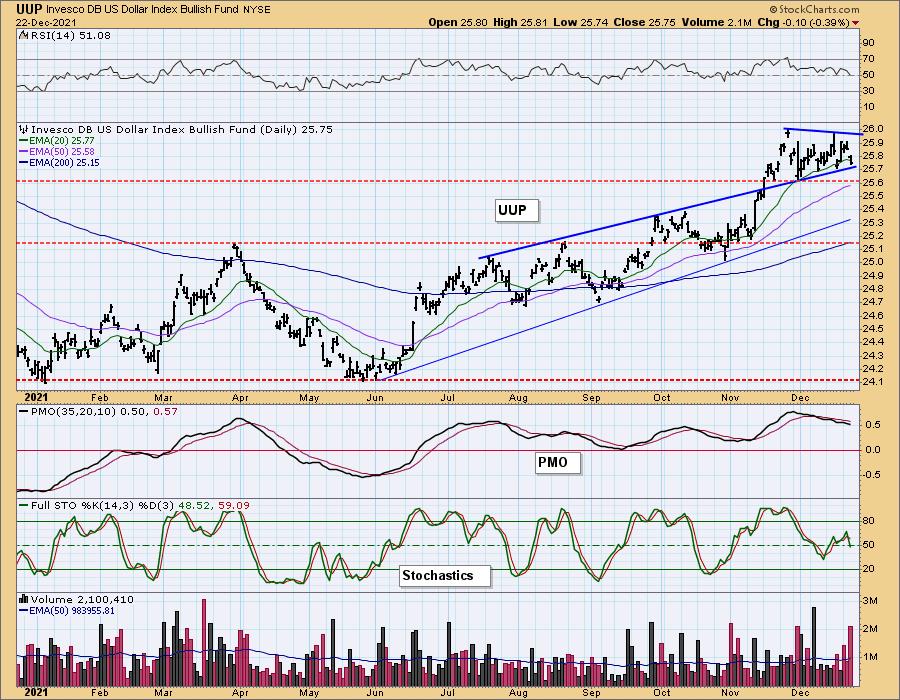
GOLD
IT Trend Model: SELL as of 12/7/2021
LT Trend Model: SELL as of 12/3/2021
GLD Daily Chart: Gold rallied and closed above all three key moving averages. The RSI is now positive and Stochastics have reversed. The best news is a new PMO BUY signal triggered.
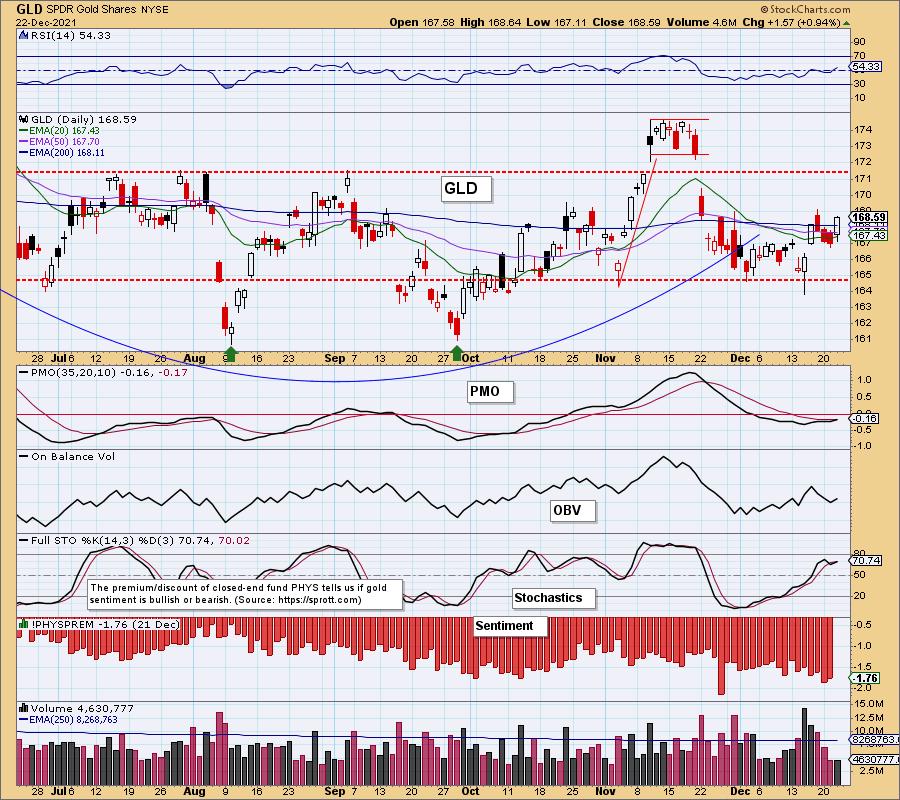
GOLD Daily Chart: Discounts are still high and that is actually a good thing for Gold given sentiment is contrarian. High discounts mean that investors are bearish. Stochastics on $GOLD haven't quite turned up, but the improvement on the RSI and positive Stochastics on GLD tempers that.
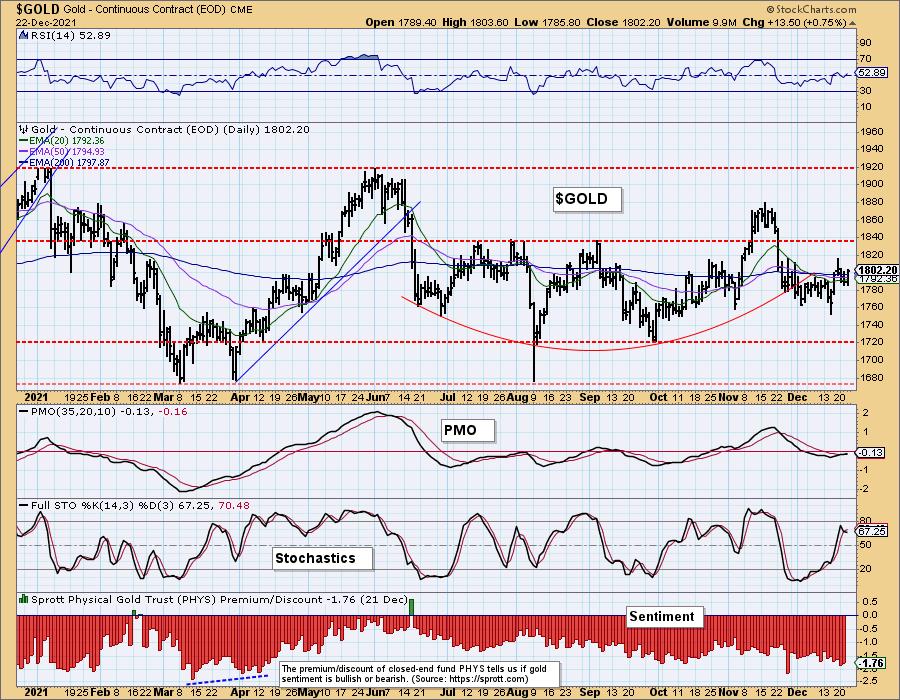
GOLD MINERS Golden and Silver Cross Indexes: Gold Miners now have a very positive bias in all three timeframes given the strong improvement in participation of stocks > 20/50/200-EMAs. Additionally, we have a PMO crossover BUY signal on tap and the RSI is now in positive territory. The 50-EMA is still posing resistance, but the improvement on the indicators suggests we should see a breakout soon.
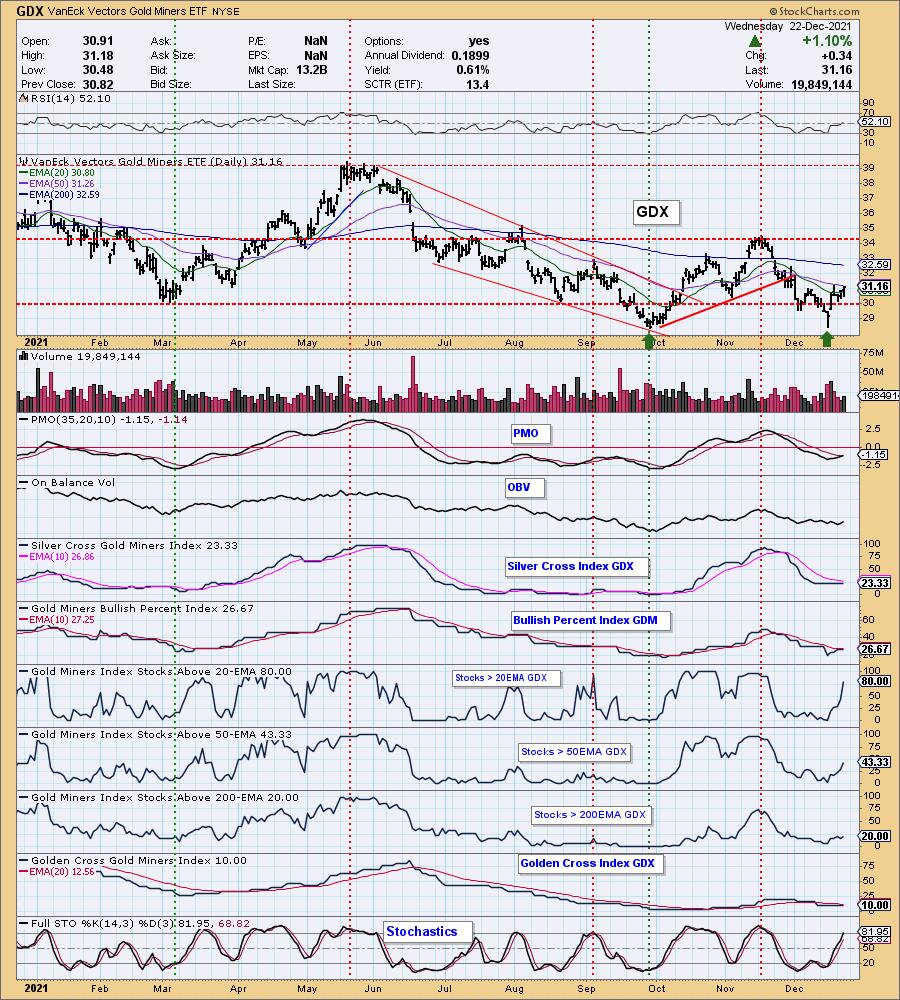
CRUDE OIL (USO)
IT Trend Model: NEUTRAL as of 11/30/2021
LT Trend Model: BUY as of 3/9/2021
USO Daily Chart: Crude Oil continued to rally today and closed above the 20-EMA. Price is now up against gap resistance and the 50-EMA. Given the newly positive RSI, rising Stochastics and PMO BUY signal, we would expect to see a breakout here.
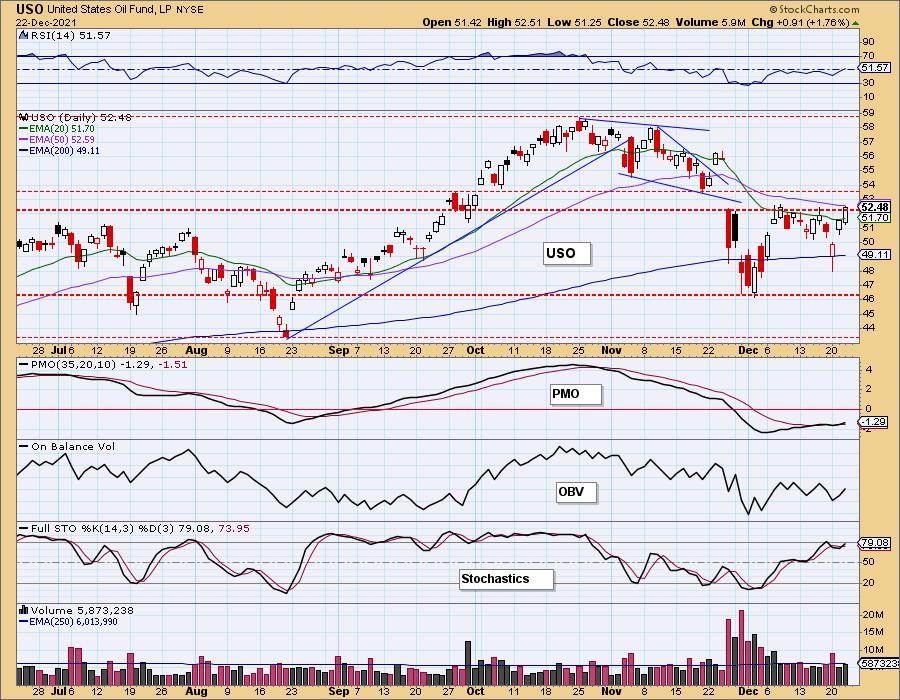
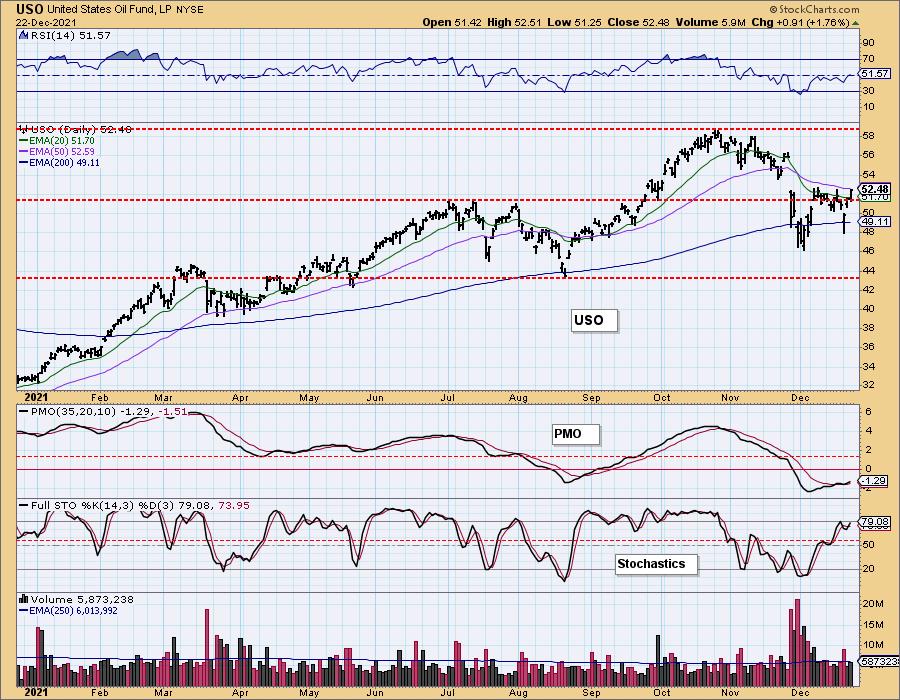
BONDS (TLT)
IT Trend Model: BUY as of 11/8/2021
LT Trend Model: BUY as of 11/5/2021
TLT Daily Chart: TLT rallied as yields fell. The chart still isn't bullish. The short-term rising trend hasn't really been recaptured and both Stochastics and PMO are falling. The RSI is in positive territory, but we don't see much upside potential here given strong overhead resistance at $151.
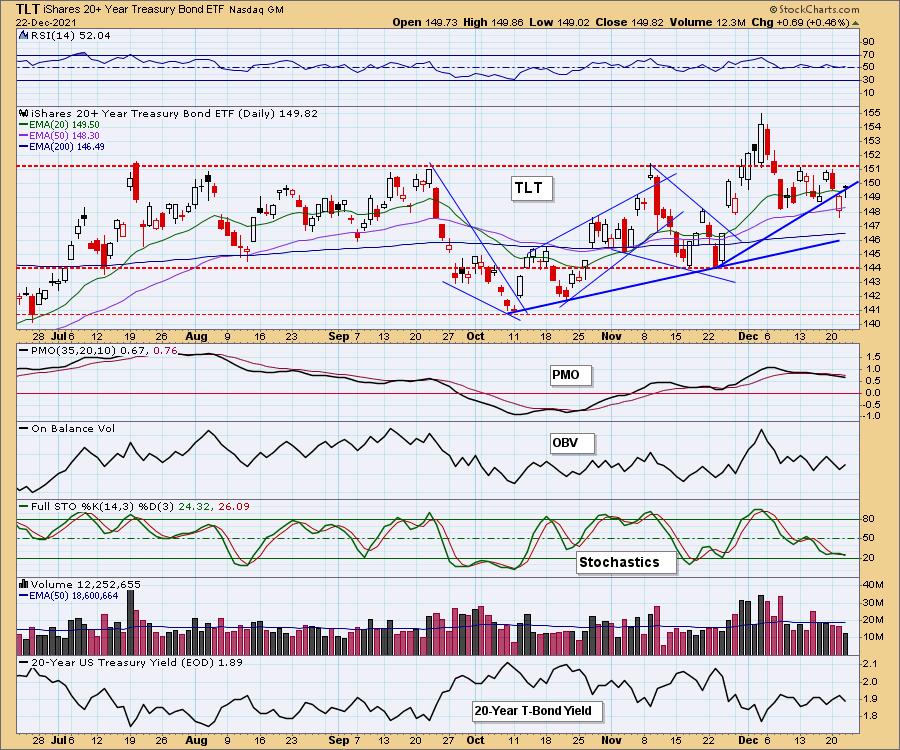
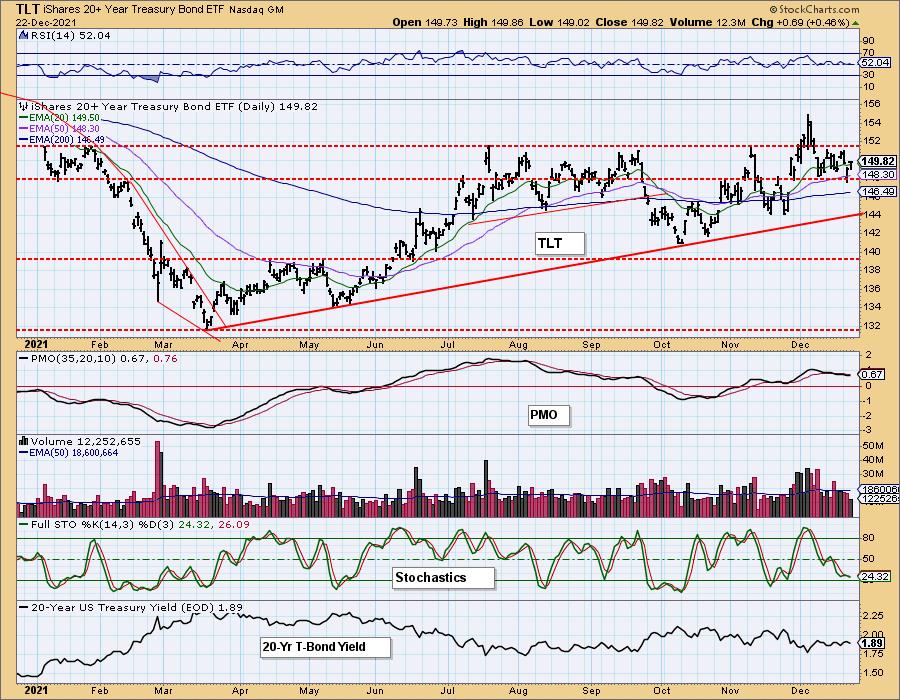
Technical Analysis is a windsock, not a crystal ball.
--Erin Swenlin
(c) Copyright 2021 DecisionPoint.com
Disclaimer: This blog is for educational purposes only and should not be construed as financial advice. The ideas and strategies should never be used without first assessing your own personal and financial situation, or without consulting a financial professional. Any opinions expressed herein are solely those of the author, and do not in any way represent the views or opinions of any other person or entity.
NOTE: The signal status reported herein is based upon mechanical trading model signals, specifically, the DecisionPoint Trend Model. They define the implied bias of the price index based upon moving average relationships, but they do not necessarily call for a specific action. They are information flags that should prompt chart review. Further, they do not call for continuous buying or selling during the life of the signal. For example, a BUY signal will probably (but not necessarily) return the best results if action is taken soon after the signal is generated. Additional opportunities for buying may be found as price zigzags higher, but the trader must look for optimum entry points. Conversely, exit points to preserve gains (or minimize losses) may be evident before the model mechanically closes the signal.
Helpful DecisionPoint Links:
DecisionPoint Alert Chart List
DecisionPoint Golden Cross/Silver Cross Index Chart List
DecisionPoint Sector Chart List
Price Momentum Oscillator (PMO)
Swenlin Trading Oscillators (STO-B and STO-V)
DecisionPoint is not a registered investment advisor. Investment and trading decisions are solely your responsibility. DecisionPoint newsletters, blogs or website materials should NOT be interpreted as a recommendation or solicitation to buy or sell any security or to take any specific action.
